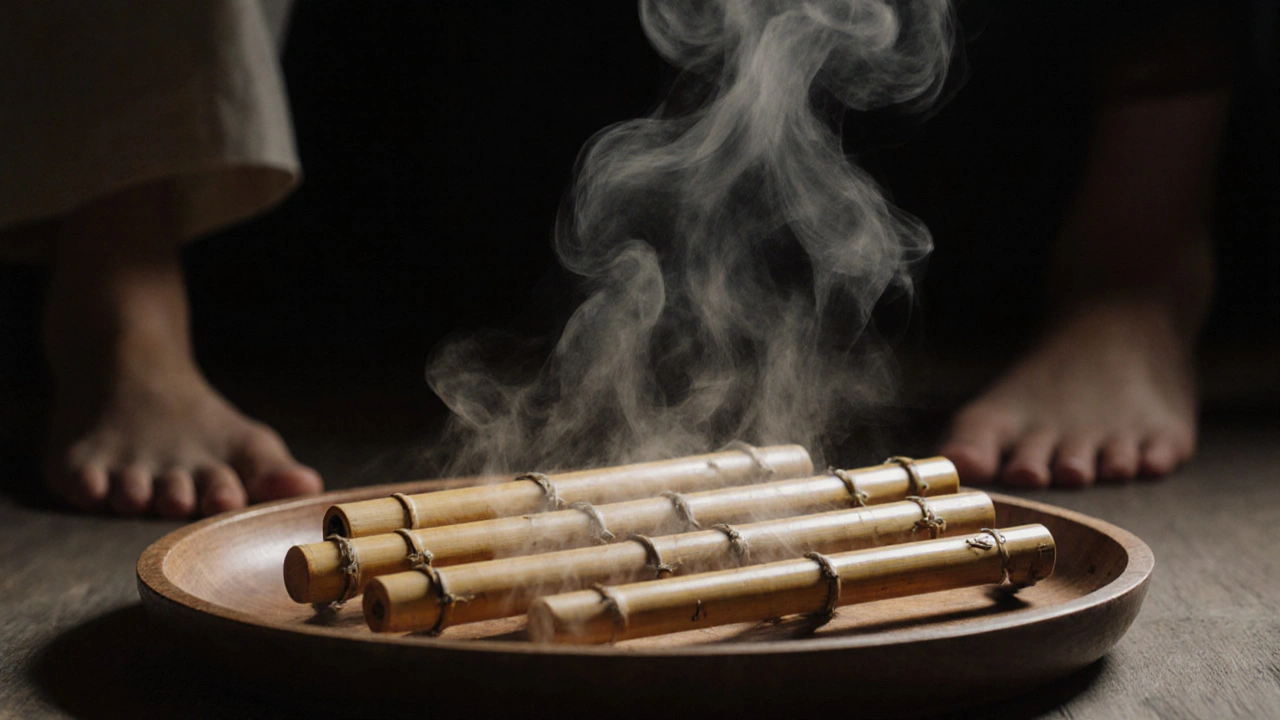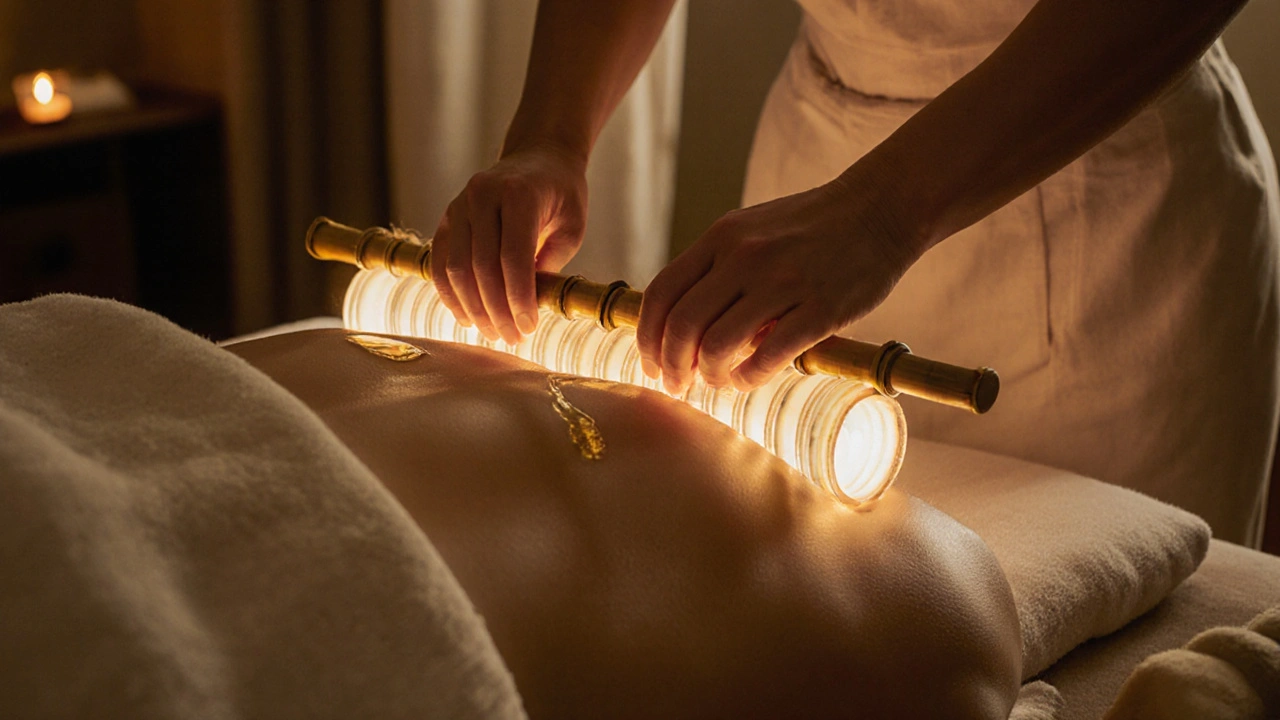Creole Bamboo Pain Relief Estimator
Personalized Pain Relief Estimate
Based on clinical studies, Creole Bamboo Massage can reduce pain by up to 68% for chronic tension. How might it help you?
Estimated Relief
Your estimated pain reduction: 0%
Based on clinical studies showing 68% pain reduction for chronic tension with Creole Bamboo Massage
Imagine warm bamboo rods gliding over your skin, rolling like waves over tense muscles, releasing knots you didn’t even know you had. This isn’t a spa fantasy-it’s Creole bamboo massage, a hands-on healing method that’s quietly gaining traction from New Orleans to Hobart. Unlike traditional Thai or Swedish massage, this technique uses hollow bamboo sticks of varying sizes, heated gently and rolled along the body’s natural contours. It’s not just about relaxation. It’s about deep, structural release-without the pressure of fingers or elbows digging in.
Where Creole Bamboo Massage Comes From
The name might sound exotic, but its roots are grounded in practicality. Creole bamboo massage didn’t emerge from ancient temples or Himalayan monasteries. It was developed in the early 2000s by a group of Louisiana-based therapists blending traditional Creole healing practices with Asian bamboo techniques. These practitioners noticed that local clients with chronic lower back pain, tight shoulders from long hours at desks, or scar tissue from surgery responded better to tools than to bare hands. Bamboo, abundant and naturally smooth, became their go-to instrument.
What makes it Creole? The rhythm. The flow. The way therapists combine slow, sweeping strokes with targeted pressure points, often incorporating gentle rocking motions learned from African and Caribbean bodywork traditions. It’s not just about the tool-it’s about the intention. The massage follows the body’s energy lines, not just the muscle fibers.
How It Works: The Science Behind the Sticks
Bamboo is hollow, lightweight, and retains heat longer than stone or metal. When warmed to around 40-45°C (104-113°F), the rods become conduits of warmth that penetrate deeper than a hot towel ever could. The heat relaxes connective tissue, while the rolling motion creates a gentle shearing effect on fascia-the web-like layer surrounding muscles that often gets stiff from stress or injury.
A 2023 study from the University of Louisiana monitored 68 participants receiving weekly bamboo massage sessions for six weeks. Those with chronic tension in the upper back and neck reported a 68% reduction in pain intensity after four sessions. Their range of motion improved by an average of 32%. The control group, receiving traditional Swedish massage, saw only a 22% pain reduction and 14% mobility gain.
Why? Bamboo’s curved surface allows therapists to apply even pressure across larger areas. Think of it like using a rolling pin instead of a knuckle to release a knot. There’s less risk of bruising, fewer trigger point flare-ups, and more consistent depth. The rods can also be used to stretch tendons and stimulate lymphatic flow, especially along the spine and legs.
What Happens During a Session
A typical Creole bamboo massage lasts 60 to 90 minutes. You lie on a warm table, draped in soft cotton. The therapist starts with the back, using longer bamboo rods-about 60 cm in length-for broad strokes from the shoulders down to the sacrum. These strokes are slow, deliberate, and rhythmic, like a tide pulling back and forth.
Then come the smaller rods-30 cm and 15 cm-used for targeted areas: the base of the skull, the outer hips, the calves. The therapist might pause on a tight spot, applying gentle pressure while rotating the rod in small circles. You might feel a deep warmth spreading, then a sudden release, like a spring uncoiling.
Some sessions include bamboo foot rolling, where the therapist uses a short rod to press along the arches and balls of the feet. This isn’t just for relaxation-it activates reflexology points linked to the spine, kidneys, and lungs. Clients often say their breathing deepens after this part.
Oil is used, but sparingly. Coconut or jojoba oil, warmed with the bamboo, helps the rods glide without slipping. No scents. No loud music. Just the soft creak of bamboo and your own breath.

Who Benefits Most
This isn’t a one-size-fits-all massage. It’s especially effective for people who:
- Have chronic muscle stiffness from sitting all day
- Struggle with fibromyalgia or myofascial pain syndrome
- Recover from sports injuries or surgeries involving scar tissue
- Find traditional deep tissue massage too intense or painful
- Want to reduce stress without sedatives or medications
It’s also a favorite among dancers, physical therapists, and musicians-anyone whose body is under constant physical demand. One violinist from Sydney told me she used to need two massage sessions a week just to play without pain. After six bamboo sessions, she cut it to once a month.
But it’s not for everyone. If you have open wounds, severe osteoporosis, or are in the first trimester of pregnancy, this isn’t the right choice. Always check with your doctor if you have implants, nerve damage, or circulatory issues.
How It Compares to Other Massage Types
| Feature | Creole Bamboo Massage | Deep Tissue Massage | Thai Massage | Swedish Massage |
|---|---|---|---|---|
| Primary Tool | Hollow bamboo rods | Therapist’s hands, elbows | Therapist’s hands, feet, knees | Therapist’s hands |
| Heat Application | Integrated (rods are warmed) | Usually none | Some (stretching creates warmth) | Occasional warm towels |
| Pressure Level | Medium to deep, even | Very deep, sometimes sharp | Variable, includes stretching | Light to medium |
| Fascia Focus | High | High | Moderate | Low |
| Duration of Relief | 5-7 days | 2-4 days | 3-5 days | 1-3 days |
| Best For | Chronic tension, scar tissue, sensitivity | Acute injuries, athletes | Flexibility, energy flow | Relaxation, light stress |
The key difference? Creole bamboo massage delivers deep work without the discomfort. Many clients say they expected pain and were surprised by how gentle it felt-even as the pressure went deep. That’s because bamboo distributes force evenly. There’s no pinching, no sudden jabbing. It’s like the muscle lets go because it trusts the tool.
What to Expect After Your First Session
Right after, you’ll feel warm, loose, and oddly light. Some people feel a little dizzy-this is normal. The release of tension can shift your nervous system from fight-or-flight to rest-and-digest. Drink water. Avoid caffeine or alcohol for the next few hours.
The next day, you might feel slightly sore, especially if you’ve had years of tightness. That’s not bruising-it’s your body adjusting. By day three, most people report better sleep, less stiffness in the morning, and a sense of calm that lasts. One client from Tasmania said she stopped taking muscle relaxants after her third session. She didn’t feel like she was ‘healed,’ but she felt like she could finally move again without thinking about it.

Where to Find It
Creole bamboo massage isn’t in every spa. It’s still a niche practice, mostly offered by independent therapists trained in specialized schools. In Australia, you’ll find it in Hobart, Byron Bay, and Melbourne, often in holistic wellness centers or studios that focus on integrative bodywork.
Ask if the therapist has completed a certified Creole bamboo training program. There’s no single governing body, but reputable schools include the Bamboo Body Institute in New Orleans and the Australian Institute of Integrative Massage. Look for therapists who mention bamboo as their primary tool-not just an add-on.
Don’t assume a ‘bamboo massage’ is the same as Creole bamboo massage. Some places use bamboo just for foot rolling or as a novelty. True Creole technique involves full-body flow, heat integration, and specific rhythm. Ask: ‘Do you follow the Creole method?’ If they hesitate, keep looking.
Why It’s More Than Just a Trend
This isn’t another spa fad. It’s a return to tools that work with the body’s natural design. Bamboo is sustainable, renewable, and biodegradable. The technique requires skill, not just equipment. It’s quiet, tactile, and deeply grounding.
In a world full of noise, screens, and rushed appointments, Creole bamboo massage offers something rare: presence. Not just the therapist’s presence-but yours. You’re not just getting a massage. You’re reconnecting with your body in a way that doesn’t demand you ‘fix’ yourself. You’re simply allowed to soften.
Is Creole bamboo massage painful?
No, it shouldn’t be. While it’s deep, the pressure is even and controlled. You might feel warmth, pressure, or a mild ache as tight areas release, but sharp pain means the therapist is going too hard. Good practitioners adjust in real time based on your feedback. If it hurts, speak up.
How often should I get a Creole bamboo massage?
For chronic tension or recovery, once a week for 4-6 weeks is ideal. After that, monthly sessions help maintain results. If you’re using it for relaxation, every 4-6 weeks is enough. Listen to your body-if you feel looser and more energized, you’re on the right track.
Can I do this at home with bamboo sticks?
You can buy bamboo rollers for self-massage, but it’s not the same. Creole bamboo massage relies on trained hands to read tension, apply heat correctly, and follow the body’s energy flow. Home tools can help with minor tightness, but they can’t replicate the depth, rhythm, or therapeutic intention of a professional session.
Does it help with cellulite or skin tone?
It doesn’t eliminate cellulite, but many clients notice improved skin texture. The rolling motion boosts circulation and lymphatic drainage, which can reduce puffiness and make skin look smoother. It’s a side benefit-not a cosmetic treatment.
Is Creole bamboo massage safe during pregnancy?
Not in the first trimester. After the first 12 weeks, some trained therapists offer modified sessions avoiding the abdomen and lower back. Always consult your doctor and choose a therapist experienced with prenatal care. Most avoid it entirely unless they’ve had specific training.
Next Steps
If you’re curious, book a 60-minute session. Wear loose clothing. Arrive 10 minutes early. Tell your therapist about any injuries, pain points, or conditions. Don’t worry about being ‘ready’-this isn’t a performance. Just show up. Let the bamboo do the work.
After your session, sit quietly for five minutes. Breathe. Notice how your body feels-not how it should feel. That’s the real healing.


 Health and Wellness
Health and Wellness